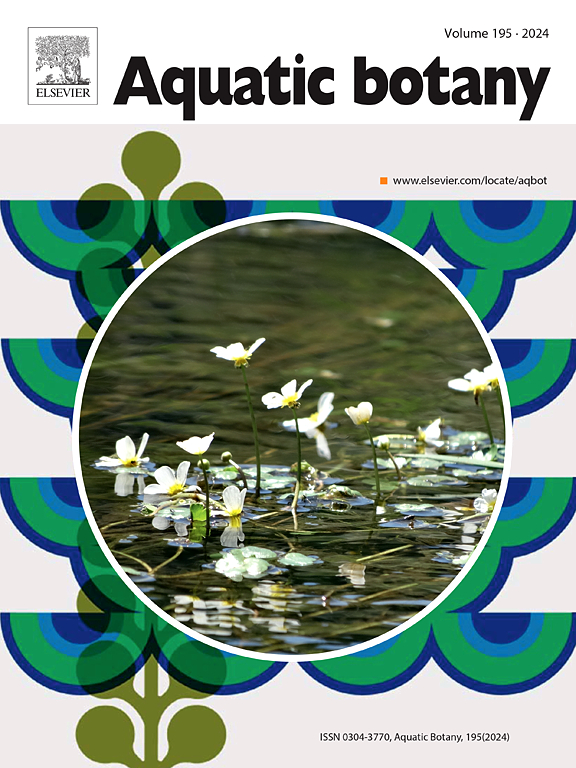Seasonal trait variation and functional niche overlap of macrophyte growth forms
IF 2.6
4区 生物学
Q2 MARINE & FRESHWATER BIOLOGY
引用次数: 0
Abstract
Macrophytes provide many ecosystem processes and functions which support freshwater ecosystem services, and the ecological role of a macrophyte is related to its growth form (emergent, free-floating, floating rooted, submerged). Differences between growth forms and the relationships between ecosystem functioning and environmental conditions can be described by functional traits. Seasonal variation in functional trait expression can lead to alterations in ecosystem functioning. As such, when inferring trait-environment relationships, a species’ functional niche should capture this temporal variation. However, it is unknown how functional traits in macrophytes vary seasonally, and the importance of between-growth form variation. Using hypervolume analysis and linear mixed effect modelling, we demonstrate that seasonal trait variation within-growth forms is stronger than between-growth form variation over time. We found that emergent macrophytes have significantly (p < 0.01) higher specific leaf area in June compared to September. Whereas leaf nutrients (total nitrogen and phosphorus), are significantly higher early in the growing season for emergent, floating rooted, and submerged plants (p < 0.05). We show that the large functional niche of submerged macrophytes is shaped by seasonal variation, and that the functional niches of all macrophyte growth forms overlap, suggesting redundancies in the maintenance of ecosystem functions. Together, this study demonstrates the influence of seasonal variation on macrophyte functional traits. Thus, seasonality is relevant to our understanding of aquatic ecosystem functioning and must be considered when determining the ecological role of macrophytes across a season. This study provides rationale for further examinations of between-growth form redundancies in the ecological role of macrophytes.
大型植物生长形态的季节性状变化与功能生态位重叠
大型植物提供了许多支持淡水生态系统服务的生态系统过程和功能,其生态作用与其生长形式(突生、自由漂浮、浮根、沉水)有关。生长形式之间的差异以及生态系统功能与环境条件之间的关系可以用功能性状来描述。功能性状表达的季节变化可导致生态系统功能的改变。因此,在推断性状-环境关系时,物种的功能生态位应该捕捉到这种时间变化。然而,目前尚不清楚大型植物的功能性状是如何随季节变化的,以及生长形式之间变化的重要性。利用超体积分析和线性混合效应模型,我们证明了生长形式内部的季节性性状变化强于生长形式之间随时间的变化。结果表明,6月份突发性大型植物比叶面积显著高于9月份(p <; 0.01)。而在生长季早期,浮根植物、浮根植物和淹水植物的叶片养分(总氮和总磷)显著较高(p <; 0.05)。研究表明,淹没植物的大型功能生态位受季节变化的影响,所有大型植物生长形式的功能生态位重叠,表明生态系统功能的维持是冗余的。总之,本研究证明了季节变化对大型植物功能性状的影响。因此,季节性与我们对水生生态系统功能的理解有关,在确定大型植物在一个季节中的生态作用时必须考虑到季节性。该研究为进一步研究大型植物在生态作用中的生长形式冗余提供了理论依据。
本文章由计算机程序翻译,如有差异,请以英文原文为准。
求助全文
约1分钟内获得全文
求助全文
来源期刊

Aquatic Botany
生物-海洋与淡水生物学
CiteScore
3.80
自引率
5.60%
发文量
70
审稿时长
6 months
期刊介绍:
Aquatic Botany offers a platform for papers relevant to a broad international readership on fundamental and applied aspects of marine and freshwater macroscopic plants in a context of ecology or environmental biology. This includes molecular, biochemical and physiological aspects of macroscopic aquatic plants as well as the classification, structure, function, dynamics and ecological interactions in plant-dominated aquatic communities and ecosystems. It is an outlet for papers dealing with research on the consequences of disturbance and stressors (e.g. environmental fluctuations and climate change, pollution, grazing and pathogens), use and management of aquatic plants (plant production and decomposition, commercial harvest, plant control) and the conservation of aquatic plant communities (breeding, transplantation and restoration). Specialized publications on certain rare taxa or papers on aquatic macroscopic plants from under-represented regions in the world can also find their place, subject to editor evaluation. Studies on fungi or microalgae will remain outside the scope of Aquatic Botany.
 求助内容:
求助内容: 应助结果提醒方式:
应助结果提醒方式:


